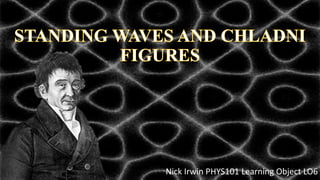
Standing Waves and Chladni Plates
- 1. Nick Irwin PHYS101 Learning Object LO6
- 2. • STANDING WAVE: a wave where each point experiences constant amplitude • Standing waves form as a result of wave interference when waves reflect off a boundary, they go in the opposite direction and will interact with incoming waves SEE: http://academic.greensboroday.org/~regesterj/potl/Waves/DiffractionInterference/standing_wave.gif • Standing waves have nodes and antinodes • NODE: the points with the smallest amplitude (zero) the point doesn’t move • ANTINODE: the points with the largest amplitude the point has the greatest movement = NODE = ANTINODE
- 3. • Chladni figures were initially discovered and subsequently studied by Robert Hooke and Ernst Chladni respectively • Chladni figures are intricate patterns which result from vibrations on a plate • Chladni figures can be explained by standing waves • Watch the video on the next slide for an example • Later discussion refers to this video www.thescienceofcreativity.com www.mat.ucsb.edu
- 4. • Chladni figures are the result of standing waves waves (of a set frequency) are propagated through a plate as the waves reach the end of the plate they reflect back the reflected waves result in interference which forms a standing wave • Each spot on the plate where the sand stops moving represents a node (zero motion) • The regions without sand indicate regions of movement (such as the antinode) = NODE = ANTINODE
- 5. • Using Chladni plates we can visualize different harmonics or resonant frequencies HARMONICS: the frequency at which the antinode amplitude of the resultant standing wave is a maximum 2nd HARMONIC (node = 1) 3rd HARMONIC (node = 2) 6th HARMONIC (node = 5)
- 6. • Chladni figures with greater complexity are caused by the waves reflecting in different directions • If mechanical waves are reflected in all three dimensions nodes can be created in three dimensional space (for example in mid air) This means that mid air nodes can be made where the air particles experience minimal movement By placing an object on these mid air nodes, you can cause objects to levitate! SEE THE NEXT SLIDE FOR A VIDEO